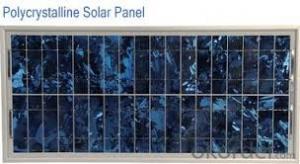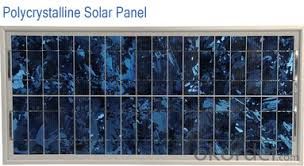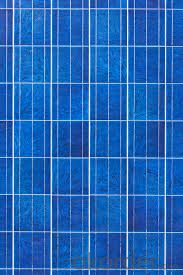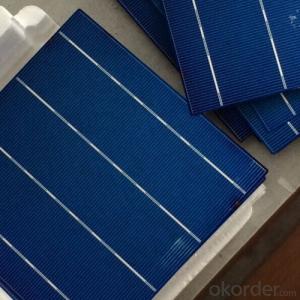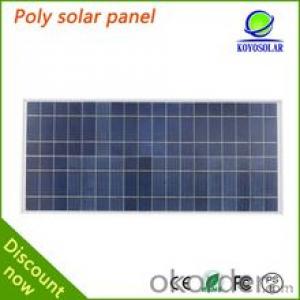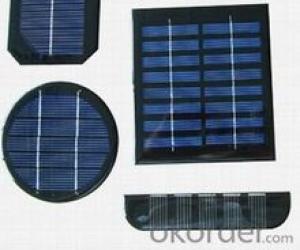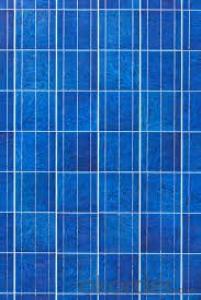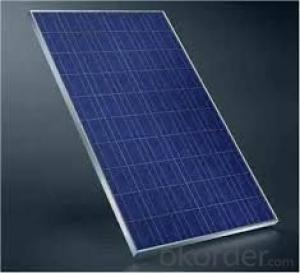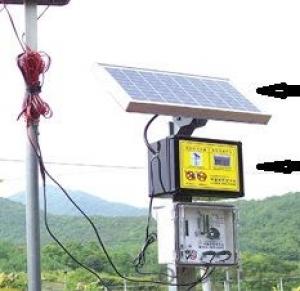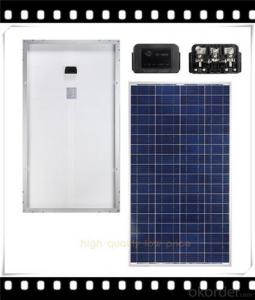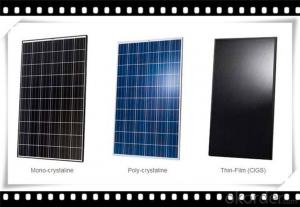Small Solar Cells Mini 2W Poly Solar Panel with 25 Years Warranty CNBM
- Loading Port:
- Qingdao
- Payment Terms:
- TT OR LC
- Min Order Qty:
- 10 set
- Supply Capability:
- 300000 set/month
OKorder Service Pledge
OKorder Financial Service
You Might Also Like
Polycrystalline Solar Modules
CNBM offers a range of small, medium and large polycrystalline solar modules, designed for a range of requirements.
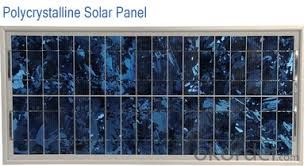
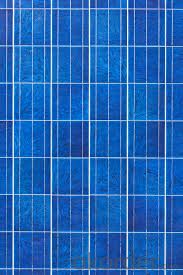
Specifications:
Tolerance | +/-3% |
Cell | Polycrystalline silicon solar cells (156 x 156mm) |
N0. of Cells | 60 (10 x 6) |
Dimension of Modules (mm) | 1650 x 990 x 40 |
Weight (kg) | 25.5 |
Limits:
Operating Temperature | -40~+85? |
Storage Temperature | -40~+85? |
Maximum System Voltage | 1000 VDC max. |
Hail Impact | Diameter of 28mm with impact speed |
Temperature and Coefficients:
NOCT | 48C+/-2? |
Voltage temperature coefficient (%/K) | -0.35 |
Current temperature coefficient (%/K) | 0.05 |
Power temperature coefficient (%/K) | -0.45 |
Characteristics:
Model: | SGM-200P | SGM-210P | SGM-220P |
Max-power voltage Vmp (V) | 29.2 | 29.4 | 29.41 |
Max-power current Imp (A) | 6.85 | 7.14 | 7.48 |
Open-circuit voltage Voc (V) | 36.5 | 36.69 | 36.9 |
Short-Circuit Current Isc (A) | 7.28 | 7.6 | 7.93 |
Max-power Pm(W) | 200 | 210 | 220 |
Model: | SGM-230P |
Max-power voltage Vmp (V) | 29.8 |
Max-power current Imp (A) | 7.72 |
Open-circuit voltage Voc (V) | 37.31 |
Short-Circuit Current Isc (A) | 8.19 |
Max-power Pm(W) | 230 |
STC: Irradiance 1000W/m2, module temperature 25?, AM-=1.5
Poly Crystalline Solar Panels Specifications Range
Maximum Power (Pm) | Dimension | Weight | Operating Voltage (Vmp) | Operating Current (Imp) | Open Circuit Voltage (Voc) | Short Circuit Current (Isc) |
0.45W | 140x80x10mm | 0.08kg | 3.3V | 150mA | 4.6V | 160mA |
1.0W | 162x140x10mm | 0.16kg | 7.5V | 150mA | 10.3V | 160mA |
4.5W | 269x251x23mm | 0.8kg | 16.5V | 0.27A | 20.5V | 0.3A |
10W | 420.1×268.9×22.6mm | 1.92kg | 17.5V | 0.58A | 20.5V | 0.6A |
20W | 425x502x50mm | 3.0kg | 16.8V | 1.19A | 21.0V | 1.29A |
30W | 593x502x22.6mm | 3.9kg | 16.8V | 1.78A | 21.0V | 1.94A |
40W | 655x537x50mm | 5.75kg | 17.3V | 2.31A | 22.1V | 2.54A |
50W | 839x537x50mm | 6.0kg | 17.5V | 2.9A | 21.8V | 3.17A |
65W | 1111x502x50mm | 7.2kg | 17.6V | 3.69A | 22.1V | 3.99A |
80W | 1204x537x50mm | 7.7kg | 17.6V | 4.55A | 22.1V | 4.8A |
- Q: Can solar cells be used in remote areas with no grid access?
- Yes, solar cells can be used in remote areas with no grid access. Solar cells convert sunlight into electricity, making them an ideal solution for remote areas where traditional power grids are not accessible. These off-grid solar systems can provide a reliable and sustainable source of electricity for various applications such as lighting, charging small devices, and powering basic appliances. Additionally, advancements in battery storage technology allow excess energy generated during the day to be stored and used during the night, ensuring continuous power supply even in remote areas without grid access.
- Q: Can solar cells be used for powering outdoor surveillance systems?
- Yes, solar cells can be used for powering outdoor surveillance systems. Solar cells convert sunlight into electricity, making them a sustainable and reliable power source for outdoor applications. This eliminates the need for traditional power sources and allows surveillance systems to operate in remote or off-grid locations. Additionally, solar-powered surveillance systems can be cost-effective and environmentally friendly, reducing energy consumption and carbon emissions.
- Q: Can solar cells be used in schools or educational institutions?
- Yes, solar cells can definitely be used in schools or educational institutions. They provide a practical and hands-on way to teach students about renewable energy sources, sustainability, and environmental stewardship. Installing solar cells in schools can also help reduce electricity costs and promote energy efficiency, making it a beneficial investment for educational institutions.
- Q: Can solar cells be used to power street lights?
- Yes, solar cells can be used to power street lights. Solar panels can convert sunlight into electricity, which can then be stored in batteries and used to power street lights during the night. This provides a sustainable and environmentally friendly solution for street lighting.
- Q: How do solar cells perform in areas with high levels of salt spray?
- Solar cells generally perform well in areas with high levels of salt spray. However, prolonged exposure to salt spray can potentially corrode the surface of the cells, reducing their efficiency over time. Regular maintenance, such as cleaning and protective coating, can help mitigate the effects of salt corrosion and ensure optimal performance.
- Q: What are the applications of solar cells?
- traffic areas: such as beacon lights, traffic / railway lights, traffic warning / sign lights, street lamps, high altitude obstruction lights, highway / railway wireless telephone booths, unattended road power supply.
- Q: How do solar cells perform in areas with high humidity and saltwater exposure?
- Solar cells can still perform well in areas with high humidity and saltwater exposure, although their efficiency may be slightly reduced. The moisture in the air and the saltwater can create a thin layer of corrosion on the surface of the solar cells, which can hinder their performance over time. However, advancements in solar cell technology, such as improved coatings and materials, have made them more resilient to these conditions. Regular cleaning and maintenance can also help mitigate the effects of humidity and saltwater exposure on solar cell performance.
- Q: How are solar cells used in military applications?
- Solar cells are used in military applications to power various devices and equipment, such as communication systems, surveillance equipment, and remote sensors. They provide a reliable and renewable source of energy in remote locations where traditional power sources may be limited or unavailable. Additionally, solar cells can be integrated into portable solar panels, backpacks, or tents, allowing soldiers to charge their electronic devices and batteries on the go, enhancing their operational efficiency and reducing their reliance on fuel-based generators.
- Q: Can solar cells be used in remote communication systems?
- Yes, solar cells can be used in remote communication systems. Solar cells are capable of converting sunlight into electrical energy, which can be used to power various devices and systems, including communication systems. This is particularly advantageous in remote areas where access to traditional power sources may be limited or non-existent. Solar-powered communication systems have been successfully deployed in remote locations, providing reliable and sustainable connectivity.
- Q: Can solar cells be used for powering airports?
- Yes, solar cells can be used for powering airports. Solar energy is a sustainable and renewable source of power, and airports have large areas of open space that can be utilized for installing solar panels. By harnessing the power of the sun, airports can reduce their reliance on non-renewable energy sources, lower their carbon footprint, and potentially save on energy costs in the long run. Additionally, solar power can also be stored in batteries for use during non-sunny periods or at night, ensuring a continuous power supply for critical airport operations.
Send your message to us
Small Solar Cells Mini 2W Poly Solar Panel with 25 Years Warranty CNBM
- Loading Port:
- Qingdao
- Payment Terms:
- TT OR LC
- Min Order Qty:
- 10 set
- Supply Capability:
- 300000 set/month
OKorder Service Pledge
OKorder Financial Service
Similar products
Hot products
Hot Searches
Related keywords
